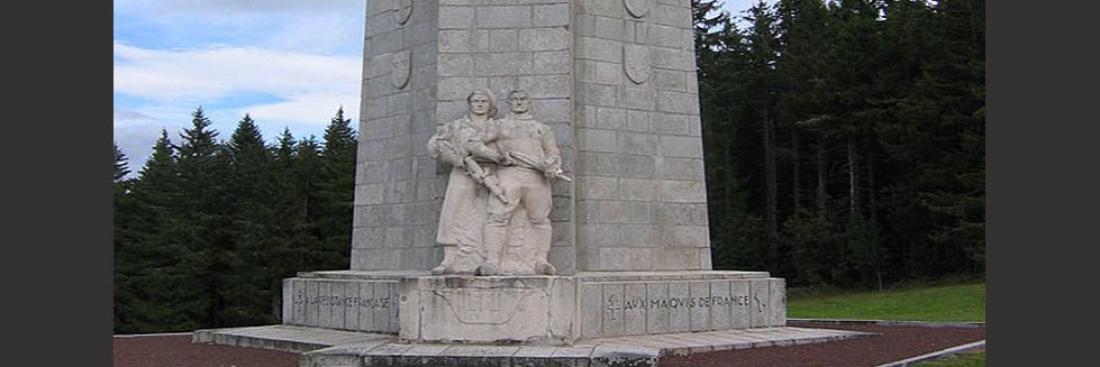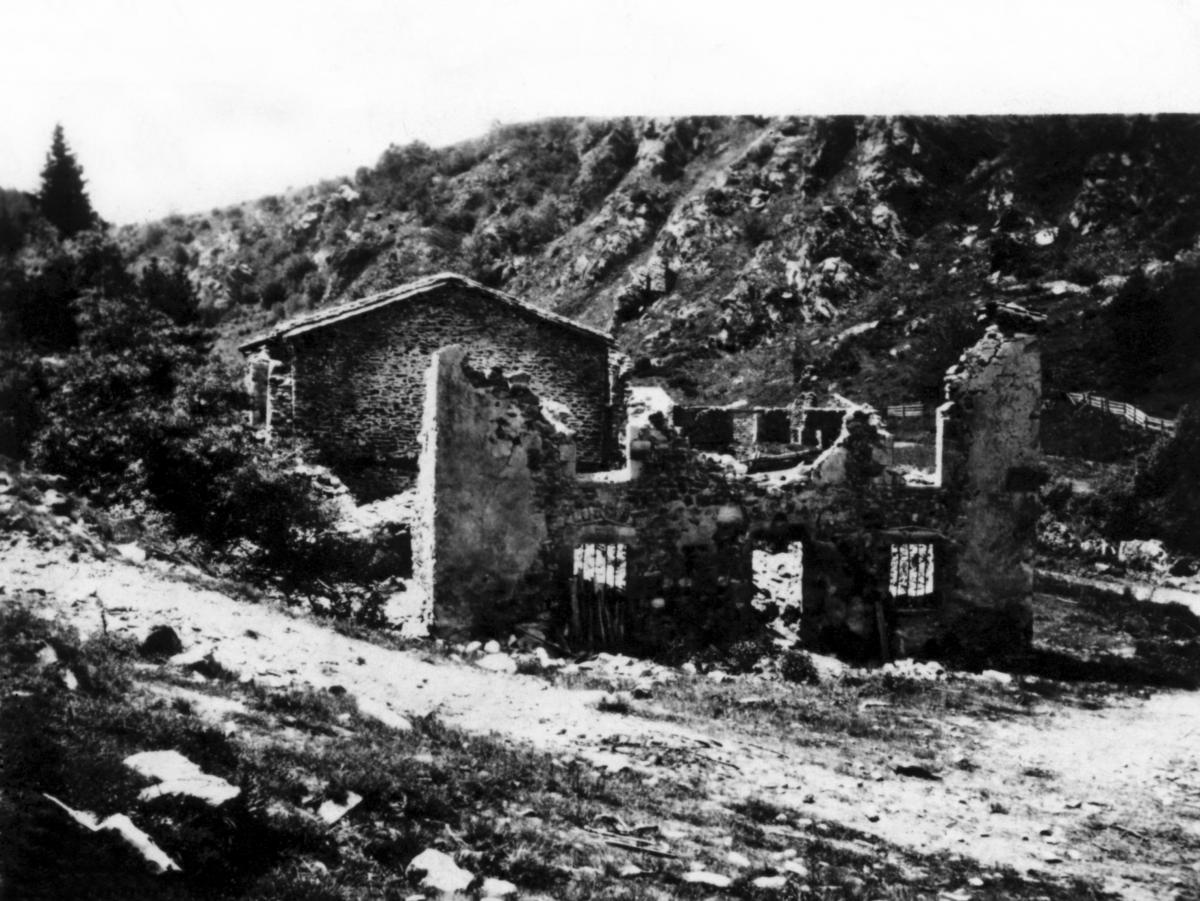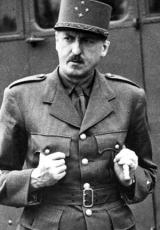Maquis du Mont Mouchet

The Maquis du Mont Mouchet, along with the Maquis du Vercors, was no doubt the largest grouping of French Résistance fighters at a single location in the nation.
It was in the magnificent landscape in the heart of the Massif de la Margeride, at an altitude of 1,400 metres on the borders of the Cantal, Lozère and Haute-Loire departments that the battle of Mont Mouchet took place. Indeed, this is where one of the five main maquis in France was located, under the authority of Colonel Gaspard (Emile Coulandon), regional head of the Forces Françaises de l'Intérieur (F.F.I. - French Forces of the Interior) for zone R.6.
In June 1940, the Allied Armies were defeated and the terrified population fled to the south. France came under the control of the Third Reich - the Vichy regime, with its harsh control of the entire population, collaboration and deportation. Some people chose to answer General de Gaulle's call, refusing defeat and organising pockets of resistance.
Carte du maquis du Mont Mouchet. Cliquez sur l'image pour voir le PDF
The Maquis du Mont Mouchet
Like their colleagues of the Maquis des Glières and the Maquis du Vercors, this maquis, located in a remote region that is hard to reach, aimed notably at being a ”fixation abscess” for the German forces as well as a grouping for many young people who refused the STO (Compulsory Work Service). In the same spirit, it was notably decided that when the Normandy landing took place, the Maquis du Mont Mouchet was to undertake delaying actions, using all possible means to keep the German troops coming up from the south from meeting up with those on the Normandy front, thus facilitating action by the Allied landing troops. It has been estimated that the fighters on Mont Mouchet included 2,700 men, broken down as follows: 1,300 from the Puy de Dôme department, 400 from the Cantal department, 400 from the Allier department, 300 from the Haute-Loire department, 300 from other regions of France as well as from other European countries (pilots who had been shot down, Jewish fugitives and antifascist resistance fighters).
The military-style organisation divided the men into companies numbered from 1 to 15 plus 3 annex companies, theoretically grouped into 4 battalions spread around all sides of the reduit.
Formation of the Maquis du Mont Mouchet
In 1943, fugitive resistance fighters and young people seeking to avoid the STO (Compulsory Work Service) ”took to the maquis” and hid in the countryside. They soon grouped together and formed ”maquis”, a word that designates the place where they came together (scrub land or bush) as well as the group of ”maquisards”. These ”maquis” grew during the winter of 1943-1944 - resistance fighters hunted by the Nazis and the Vichy ”Milice” who had to leave their homes, and many young people who refused the STO and chose the underground struggle. They were mainly part of three Résistance organisations, the M.U.R. (Mouvements Unis de Résistance - United Movements of the Resistance), F.T.P. (Francs-Tireurs et Partisans - Partisan Irregular Riflemen) and the O.R.A. (Organisation de Résistance de l'Armée - Resistance Organisation of the Army).
In the spring of 1944, the maquis received reinforcements from the A.S. (Armée Secrète - Secret Army) of the United Movements of the Resistance - they were then called the F.F.I. (Forces Françaises de l'Intérieur - French Forces of the Interior). In London, General Koenig was the commander in chief. The national military staff was headed by Colonel Pontcarral (Dejussieu). The head of the F.F.I. in Auvergne was Colonel Gaspard (Emile Coulaudon), assisted by Prince (Muguet) and Monique (Montpied).
The Armée Secrète formed small groups which, when the time came, sabotaged and ”waged guerrilla war” on all locations where the German troops passed through. The possibility of bringing together larger groups was studied in London in 1943. The allied high command dreamed of setting up a solid ”bastion” in the Massif Central to block enemy divisions coming up from the south. This ambitious plan, called the ”Billotte Plan”, was later abandoned.
On 15 April 1944,in Montluçon, Colonel Gaspard met with Major Philippe (Maurice Southgate), head of a Buckmaster network (the English Buckmaster network made up the France Section of the S.O.E.: Special Operations Executive). The idea of a large concentration of maquisards and the massive parachuting of arms and ammunition was adopted and quickly approved in London.
On 15 May 1944, in Paulhaguet (Haute-Loire department), the heads of the Resistance Movements in the Auvergne region, in a meeting presided by Rouvres (Henri Ingrand), unanimously approved the formation of ”reduits”. On 20 May, the regional military staff headquarters ordered the mobilisation of all the volunteers in the various resistance movements. ”Maquis” and ”corps-francs”, mainly from the Puy-de-Dôme department, had already reached Mont Mouchet. For two weeks, thousands of volunteers headed to La Margeride on foot or by bicycle, in trucks or by train. There were 2,700 men at Mont Mouchet, 1,500 at Chaudes-Algues (Réduit de la Truyère) and 5,000 at Saint-Genest. At Clavières, one of the entrances to the ”Réduit du Mont Mouchet”, a sign announced: ”Ici, commence la France libre!” (”Free France starts here!”).
The military staff headquarters was set up at the Mont Mouchet Forester's House. The ”Le Mur d'Auvergne” newspaper, whose first issue was printed on underground presses in February 1944, was then printed at the staff headquarters' command post and made a major contribution to keeping up the morale of all the volunteers.
Fifteen Companies were formed, along with the ”Corps-francs” Company, the ”Pioneers” Company, the CHR (Administrative and Logistics Company) and transport company with a fleet of automobiles made up of some ten vehicles. Each fighter received a rifle, a carbine or a machine gun. Each Company had 9 automatic rifles and some one hundred fragmentation grenades. Five Companies were equipped with 2 bazookas and 2 light machine guns (the 12th Company: 4 bazookas and 4 light machine guns).
Each volunteer was equipped with kaki shorts, a brown or black jacket, a pair of English shoes and a red armband with a black three-figure number and a blue Cross of Lorraine on a white background. The Resistance fighters in the Haute-Loire department were gathered together in the sector of Saugues-Venteuges; 1,200 joined the reduit. Six Companies were formed, numbered from 31 to 36, and received light weapons. An itinerant Company joined up with more than 400 unarmed men.
The battle
On 2 June 1944, a German battalion from Mende was headed toward Saint-Chély-d'Apcher, Le Malzieu and Paulhac. For three hours, the 2nd Company from Mont Mouchet resisted against the Germans who were trying to take over their position. That is when the 3rd Company and the Corps-Franc des Truands intervened. A counterattack was then launched against the enemy's flank by the 12th Company that came running from Chamblard. The German battalion had to pull back after after suffering heavy losses. Only three Maquisards were slightly wounded.
Here is the text of the decision sent by Colonel Garcie to his troops the next day, on 3 June 1944.
On 7 June, a group of Maquisards came by stages from the region of Le Puy and was stationed at Rossignol, a community in Saint-Jean-Lachalm. It was surrounded by a German column from Le Puy. It broke out of its encirclement with a certain number of losses, crossed the Allier at Alleyras, and reached Venteuges that night with a few casualties. The night before the German attack, defences were in place in the Venteuges sector and the roads leading to the reduit were all under control. The eastern flank of Mont Mouchet was covered.
On 10 June, between 2,800 and 3,000 men were lined up on the German side: the 2,000 soldiers sent were reinforced by companies from Saint-Flour, Brioude and Le Puy. These reinforcements included 6 Volga Tatar companies: 3 Azeri companies from Saint Flour and 3 Ukraino-Tatar companies from Le Puy, for a total of 900 men. There was fierce fighting throughout the day of 10 June. At Clavières, the Germans were halted by the 3rd, 4th and 9th Companies. Their armoured vehicles, mainly light tanks and armoured cars, moved ahead slowly, but the infantry was unable to keep up. A certain number of vehicles were destroyed by our bazookas and our automatic weapons. The attack was stopped by the Corps-Francs des Truands and the 10th, 11th and 14th Companies at the Pinols crossroads, destroying several trucks loaded with enemy soldiers. At La Vachellerie (in the Saugues sector), some one hundred vehicles were stopped by the Gendarmes unit, platoons from the 33rd and 34th Companies, with reinforcements from elements of the 12th Company. There was fierce fighting all day long, and it took a counterattack by two platoons from the 31st Company against the enemy's flank in the evening to push the attack back to the right bank of the Allier River. Several enemy vehicles were destroyed, including one armoured vehicle. Two cannons fell into the hands of the F.F.I. as well as several prisoners. The German troops withdrew at the end of the evening. The F.F.I. headquarters expected another, more violent, attack the next day; which is why they started to evacuate materiel along the Paulhac and Le Malzieu roads, which were still open, toward the ”Réduit de La Truyère”.
The German attack started up again on 11 June at about 9.00 am along the same lines as the day before. The fighting was fierce. The artillery crushed the Companies engaged and, at the end of the evening, the Forester's House where the Command Post was located. Everywhere, at Clavières, Pinols and Saugues, the Maquisards fought courageously, but were unable to hold back the enemy advances. Ammunition ran out and the reserve units brought in the necessary supplies. The 26th Company, mainly from the canton of Laroquebrou, suffered heavy losses: one-third of its men. The Companies received the order to hold on until nightfall. Those at Mont Mouchet pulled back toward the Réduit de La Truyère. Those at the Reduit de Saugues, the 31st and 32nd Companies, pulled back toward the forests in the region of Berbezit (La Chaise-Dieu), and toward the region of the forest of Mercoire (Haute-Lozère) for the 33rd, 34th and 35th Companies and the Passage Company. Much later, when the Germans reached the Forester's House, they found nothing - no men, no materiel. During the fierce fighting, the Germans burnt and pillaged the villages of Clavières, Lorcières and Paulhac, part of the little town of Ruynes-en-Margeride, and all the isolated farms along their route within 10 km around Mont Mouchet. Just about everywhere, they shot the inhabitants of the region, notably 26 people at Ruynes, 13 at Clavières and 11 at Pinols. They continued to commit their atrocities as they withdrew, including 25 hostages who were shot on 14 June at Soubizergues Bridge in Saint-Flour, while 120 people were deported from Murât on 12 and 24 June.
At the ”Réduit de La Truyère”, 1,500 men came together under the orders of Colonel Thomas (Mondange), whose Command Post was set up at Fridefonds. The Companies that withdrew from Mont Mouchet arrived on 12 and 13 June and set up camp at the Reduit. Staff Headquarters set up their Command Post at Saint-Martial. There was a total of some 4,000 men in all. For a week, arms and ammunition were parachuted in and distributed. During the morning of 20 June, there were15,000 to 20,000 men (Wehrmacht, SS, Luftwaffe and the Milice combined). At Pont-Rouge, on the Laguiole road, the 8th Company resisted for two hours; the Brinat platoon lost one-third of its men. Further on, at Védrines Woods, the rest of the 8th Company supported the defensive actions the best it could, assisted by the Aubrac Company and by the Corps-Franc Laurent (Llorca). Part of the German column continued to advance toward Chaudes-Aiguës, which was occupied at 12.45 pm. There was 8 hours of fierce fighting at Anterrieux, at a locality called ”La Barre de Fer”. The 7th Company fought heroically and suffered heavy losses. From the village of Auriac, cannons bombarded Fridefonds over the Cirque de Mallet. Bombs rained down on the villages of the Reduit, notably Saint-Martial and Anterrieux, and on the main military objectives, from airplanes swooping in at low altitudes and from bombers at the end of the afternoon. Faced with the violent fire from the artillery, and given the general positioning of the forces, Colonel Gaspard finally decided to order disengagement at nightfall. Nearly all the F.F.I. units cut off contact and headed to the north of La Truyère (Lavastrie). The others crossed the Bès at Albaret-le-Contal, notably the Medical Services under Commander Bénévole (Max Menut). Nine people, including six who had been seriously injured, were executed near Saint-Just on 22 June. The courage and the sacrifices of the Maquisards, whose heavy losses - 260 killed and 180 injured - barely exceed those of the Germans, enabled them to block two German divisions at just the right time, as they were heading up to the Normandy front.
Liberation
At the end of June and in early July, the F.F.I. Companies were reconstituted and spread out over the four departments in the Auvergne region. They kept up the fight until the region was completely liberated. With the collaboration of the F.F.I. from the Limousin region, they pushed back 22,000 German soldiers and forced them to surrender south of the Loire River (Bec d'Allier). Many Maquisards then signed up with the French Army for the rest of the war and continued to fight all the way to Germany.
Sources: SGA/DMPA -Mont Mouchet. A major chapter of the Resistance (Touriste en Auvergne, No. 24)

Memorial to the Resistance on Mont Mouchet (Haute Loire, France). Source: GNU Free Documentation License

Memorial to the Resistance on Mont Mouchet (Haute Loire, France). Source: GNU Free Documentation License

Groupe de FFI partant pour le Mont-Mouchet. Date inconnue. Copyright collection particulière.

Goupe de FFI dans un village proche du Mont-Mouchet. Date inconnue. Copyright collection particulière.

Tombe d'un FFI tombé au combat sur le plateau du Mont-Mouchet. Copyright collection particulière.

La ferme du Gastier entre le "Crepau" et la "Pane", après les combats de juin 1944. Copyright collection particulière.

Monument commémoratif des combats du maquis du Mont-Mouchet. Erigé à la faveur d'une souscription nationale, il est inauguré le 9 juin 1946. Copyright collection particulière.



